13.021 Marine Hydrodynamics, Fall 2003
Lecture 3
Copyright © 2003 MIT - Department of Ocean Engineering,
All rights reserved.
13.021 - Marine Hydrodynamics
Lecture 3
Stress Tensor
 . The stress (force per
unit area) at a point in a fluid needs nine components to be
completely specified, since each component of the stress must be
defined not only by the direction in which it acts but also the
orientation of the surface upon which it is acting. The first
index specifies the direction in which the stress
component acts, and the second identifies the orientation of the
surface upon which it is acting. Therefore, the
. The stress (force per
unit area) at a point in a fluid needs nine components to be
completely specified, since each component of the stress must be
defined not only by the direction in which it acts but also the
orientation of the surface upon which it is acting. The first
index specifies the direction in which the stress
component acts, and the second identifies the orientation of the
surface upon which it is acting. Therefore, the  component of the force acting on a surface whose outward normal
points in the
component of the force acting on a surface whose outward normal
points in the  direction is
direction is  .
.
Figure 1:
Shear stresses on an
infinitesimal cube whose surface are parallel to the coordinate system.
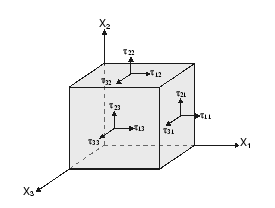 |
Figure:
Consider an
infinitesimal body at rest with a surface PQR that is not perpendicular to any of the
Cartesian axis. The unit normal vector to that surface is
 . The area of the surface
. The area of the surface  , and
the area of each surface perpendicular to
, and
the area of each surface perpendicular to  is
is
 , for
, for  .
.
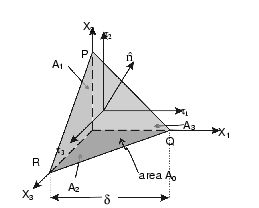 |
Newton's law:

= (volume
force)

for
i = 1, 2, 3
If  is the typical dimension of the body is the typical dimension of the body |
: surface forces
 |
| |
: volume forces
 |
 and
and
 . But the area of each surface
. But the area of each surface  to
to  is
is
 . Therefore
. Therefore
 , where
, where
 is the
is the  notation (represents the sum of all components).
Thus
notation (represents the sum of all components).
Thus
 for i = 1, 2, 3, where
for i = 1, 2, 3, where
 is the component of stress in the
is the component of stress in the  direction on
a surface with a normal
direction on
a surface with a normal  . We call
. We call

 the stress vector and we
call
the stress vector and we
call  the stress matrix or tensor.
the stress matrix or tensor.
In a static fluid, the stress vector cannot be different for
different directions of the surface normal since there is no
preferred direction in the fluid. Therefore, at any point in the
fluid, the stress vector must have the same direction as the
normal vector  and the same magnitude for all directions
of
and the same magnitude for all directions
of  .
.
Pascal's Law: for hydrostatics![$\displaystyle \hspace{5mm}\tau _{ij}
=\overset{\mbox{no summation}}{\overbrace...
...ray}{ccc}-p_{1} & 0 & 0 0 & -p_{2} & 0 0 & 0
& -p_{3}\end{array} \right]$](img34.gif) |
|
where  is the pressure acting perpendicular to the
is the pressure acting perpendicular to the  surface. If
surface. If  is the pressure acting perpendicular to the
surface PQR, then
is the pressure acting perpendicular to the
surface PQR, then
 , but
, but
 .
Therefore
.
Therefore
 , i = 1, 2, 3 and
, i = 1, 2, 3 and  is
arbitrary.
is
arbitrary.
To prove the symmetry of the stress tensor we follow the steps:
Figure 3:
Material element under tangential
stress.
 |
- The
 of surface forces
of surface forces  body forces
body forces  mass
mass acceleration. Assume no symmetry. Balance of the
forces in the
acceleration. Assume no symmetry. Balance of the
forces in the  direction gives:
direction gives:
since surface forces are
 , where the
, where the
 terms include the body
forces per unit depth. Then, as
terms include the body
forces per unit depth. Then, as
 .
.
- The
 of surface torque
of surface torque  body moment
body moment  angular
acceleration. Assume no symmetry. The balance moment with respect
to
angular
acceleration. Assume no symmetry. The balance moment with respect
to  gives:
gives:
since the body moment is proportional to
 . As
. As
 ,
,
 .
.
Consider a material volume
 and recall that a
material volume is a fixed mass of material. A material volume
always encloses the same fluid particles despite a change in size,
position, volume or surface area over time.
and recall that a
material volume is a fixed mass of material. A material volume
always encloses the same fluid particles despite a change in size,
position, volume or surface area over time.
The mass inside the material volume is:
Figure 4:
Material volume
 with
surface
with
surface  .
.
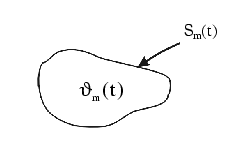 |
Therefore the time rate of increase of mass inside the
material volume is:
which implies conservation of mass for the material volume
 .
.
The velocity of fluid inside the material volume in the  direction is denoted as
direction is denoted as  . Linear momentum of the material
volume in the
. Linear momentum of the material
volume in the  direction is
direction is
Newton's law of motion: The time rate of change of momentum of the
fluid in the material control volume must equal the sum of all the
forces acting on the fluid in that volume. Thus:
 momentum momentum |
 body force body force surface force surface force |
|
 |
 |
|
| Divergence Theorems: |
For vectors:
 |
| |
For tensors:
 |
Thus using divergence theorems:
 , , |
which gives the conservation of the momentum for the material
volume
 .
.
Consider a flow through some moving control volume
 during a small time interval
during a small time interval  t. Let
t. Let
 be any (Eulerian) fluid property per
unit volume of fluid (e.g. mass, momentum, etc.). Consider the
integral
be any (Eulerian) fluid property per
unit volume of fluid (e.g. mass, momentum, etc.). Consider the
integral
According with the definition of the derivative, we can write
Figure 5:
Control volume  and its
bounding surface
and its
bounding surface  at instants
at instants  and
and
 .
.
 |
Next, we consider the steps
- Taylor series expansion of f about t.
-
 where
where
![$ \iiint\limits_{\Delta
\vartheta } d\vartheta =
\iint\limits_{S(t)}\left[U_{n}(\vec{x},t)\Delta t\right]dS $](img76.gif) and
and
 is the normal velocity of
is the normal velocity of  .
.
Figure 6:
Element of the surface  at instants
at instants
 and
and
 .
.
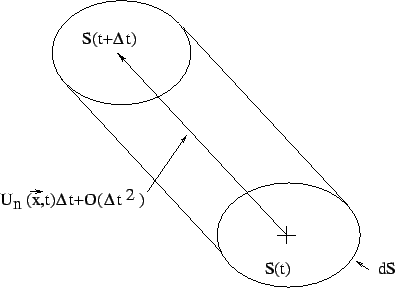 |
So we have
Kinematic Transport Theorem (KTT)  Leibnitz rule in 3D
Leibnitz rule in 3D
If the control volume is a material volume:
 and U
and U
 , where
, where  is
the fluid particle velocity. Then the Kinematic Transport theorem (KTT) assume the form
is
the fluid particle velocity. Then the Kinematic Transport theorem (KTT) assume the form
Using the divergence theorem:
 |
(1) |
1 Kinematic Transport Theorem (KTT)
Kinematic Transport Theorem (KTT)
where f is a fluid property per unit volume.
Let the fluid property per unit volume be mass per unit volume (
f  )
)
since
 is arbitrary, so the integrand
is arbitrary, so the integrand
 everywhere. Therefore, the differential form
of conservation of mass i.e. Continuity equation follows:
everywhere. Therefore, the differential form
of conservation of mass i.e. Continuity equation follows:
Therefore,
In general,
 . We consider
the special case of incompressible flow (Note, the
density of the entire flow is not constant when we have more than
one fluid, like water and oil, as illustrated in the picture
above).
. We consider
the special case of incompressible flow (Note, the
density of the entire flow is not constant when we have more than
one fluid, like water and oil, as illustrated in the picture
above).
Figure 7:
Interface of two fluids (oil-water)
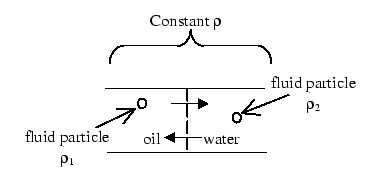 |
Therefore, for an incompressible flow:
Then
 , which is the
Continuity equation for incompressible fluid.
, which is the
Continuity equation for incompressible fluid.
2 Kinematic Transport Theorem ( = 1
Kinematic Transport Theorem ( = 1 KTT + continuity
equation). If
KTT + continuity
equation). If  = fluid property per unit mass, then
= fluid property per unit mass, then

 = fluid property per unit volume
= fluid property per unit volume
and the 2 Kinematic Transport Theorem (KTT) follows:
Kinematic Transport Theorem (KTT) follows:
We consider  as the
as the  momentum per unit mass (
momentum per unit mass (  ).
Then,
).
Then,
But
 is an arbitrary material volume,
therefore the integral identity gives Euler's equation
is an arbitrary material volume,
therefore the integral identity gives Euler's equation
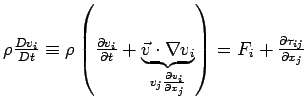 , , |
and its Vector Tensor Form
Karl P Burr
2003-08-24
![]() . The stress (force per
unit area) at a point in a fluid needs nine components to be
completely specified, since each component of the stress must be
defined not only by the direction in which it acts but also the
orientation of the surface upon which it is acting. The first
index specifies the direction in which the stress
component acts, and the second identifies the orientation of the
surface upon which it is acting. Therefore, the
. The stress (force per
unit area) at a point in a fluid needs nine components to be
completely specified, since each component of the stress must be
defined not only by the direction in which it acts but also the
orientation of the surface upon which it is acting. The first
index specifies the direction in which the stress
component acts, and the second identifies the orientation of the
surface upon which it is acting. Therefore, the ![]() component of the force acting on a surface whose outward normal
points in the
component of the force acting on a surface whose outward normal
points in the ![]() direction is
direction is ![]() .
.


![]() and the same magnitude for all directions
of
and the same magnitude for all directions
of ![]() .
.
![$\displaystyle \hspace{5mm}\tau _{ij}
=\overset{\mbox{no summation}}{\overbrace...
...ray}{ccc}-p_{1} & 0 & 0 0 & -p_{2} & 0 0 & 0
& -p_{3}\end{array} \right]$](img34.gif)
![]() and recall that a
material volume is a fixed mass of material. A material volume
always encloses the same fluid particles despite a change in size,
position, volume or surface area over time.
and recall that a
material volume is a fixed mass of material. A material volume
always encloses the same fluid particles despite a change in size,
position, volume or surface area over time.


![]() direction is denoted as
direction is denoted as ![]() . Linear momentum of the material
volume in the
. Linear momentum of the material
volume in the ![]() direction is
direction is




 ,
,![]() during a small time interval
during a small time interval ![]() t. Let
t. Let
![]() be any (Eulerian) fluid property per
unit volume of fluid (e.g. mass, momentum, etc.). Consider the
integral
be any (Eulerian) fluid property per
unit volume of fluid (e.g. mass, momentum, etc.). Consider the
integral



 where
where
![$ \iiint\limits_{\Delta
\vartheta } d\vartheta =
\iint\limits_{S(t)}\left[U_{n}(\vec{x},t)\Delta t\right]dS $](img76.gif) and
and




![$ \frac{d}{dt} \iiint\limits_{\vartheta_{m}(t)} f\left(
\vec{x},t\right)d\varth...
...rtial
x_{i}}(fv_{i})}{\underbrace{
\nabla\cdot(f\vec{v})}}\right]d\vartheta, $](img90.gif)
![]() )
)
![$\displaystyle 0\underset{\underset{\underset{\mbox{\footnotesize {of mass}}}
{...
...ho
}{\partial t} +\nabla \cdot \left( \rho \vec{v} \right) \right]
d\vartheta$](img92.gif)
![\begin{displaymath}\begin{split}
& \frac{\partial \rho }{\partial t} +\nabla \c...
...\right.}}+\left.\rho\nabla\cdot\vec{v}
\right] = 0 \end{split}\end{displaymath}](img94.gif)
![]() . We consider
the special case of incompressible flow (Note, the
density of the entire flow is not constant when we have more than
one fluid, like water and oil, as illustrated in the picture
above).
. We consider
the special case of incompressible flow (Note, the
density of the entire flow is not constant when we have more than
one fluid, like water and oil, as illustrated in the picture
above).
 , which is the
Continuity equation for incompressible fluid.
, which is the
Continuity equation for incompressible fluid.
![]() Kinematic Transport Theorem ( = 1
Kinematic Transport Theorem ( = 1![]() KTT + continuity
equation). If
KTT + continuity
equation). If ![]() = fluid property per unit mass, then
= fluid property per unit mass, then
![]()
![]() = fluid property per unit volume
= fluid property per unit volume
![\begin{displaymath}\begin{split}
\frac{d}{dt} \iiint\limits_{\vartheta_{m}(t)} ...
... t} +\vec{v} cdot\nabla G\right)}}\right]d\vartheta,\end{split}\end{displaymath}](img103.gif)

![]() as the
as the ![]() momentum per unit mass (
momentum per unit mass ( ![]() ).
Then,
).
Then,

 ,
,